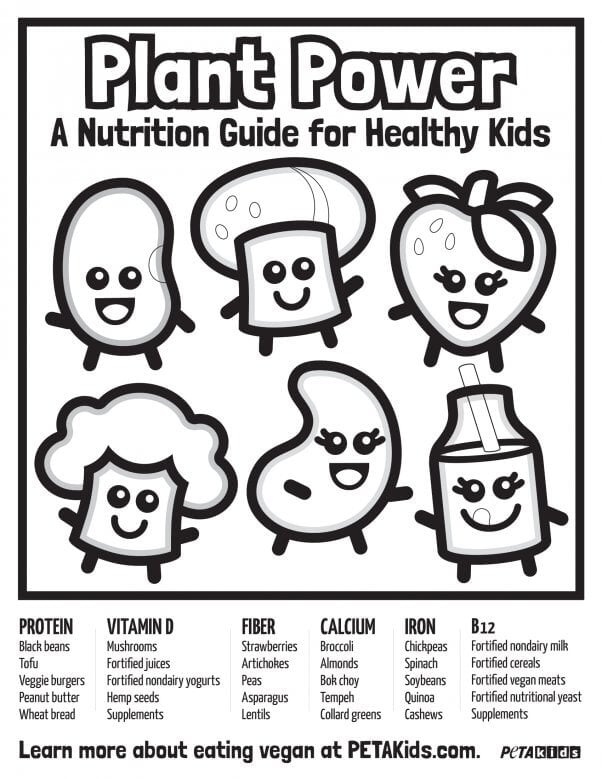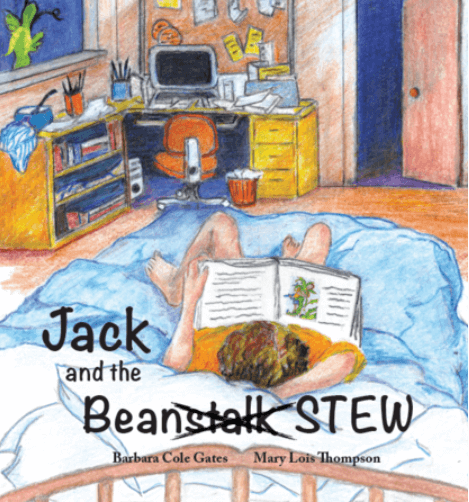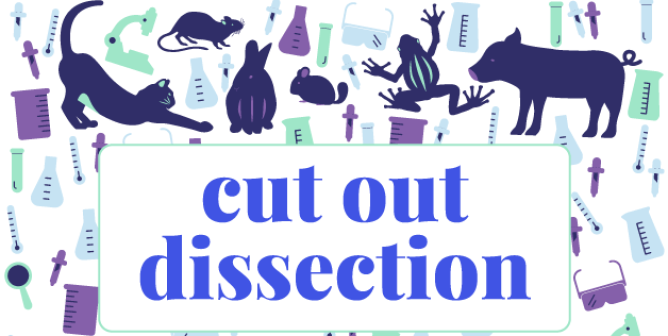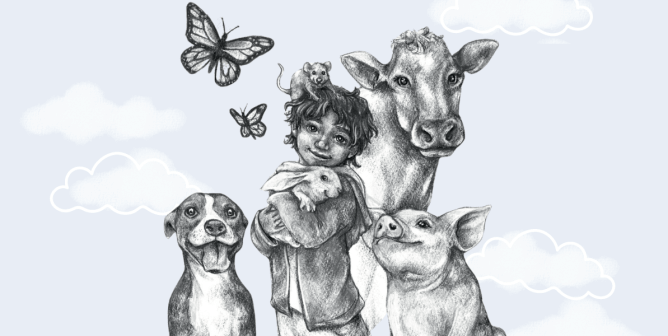‘Jack and the Bean Stew’: A Tale of Plants, Animals, and Adventure
Jack and the Bean Stew by Barbara Cole Gates, founder and president of Lean & Green Kids, is a story about a young boy who finds himself on an adventure after he is given some magical beans. Children will enjoy the creative allusions to favorite fairy tale characters from familiar stories such as “Goldilocks and the Three Bears,” “Little Red Riding Hood,” “Snow White and the Seven Dwarfs,” and “Jack and the Beanstalk.” Its message highlights the real-life power of beans and other vegan foods to support health. Embracing a vegan lifestyle also saves animals and helps protect the environment. Engage your students and teach them the importance of eating vegan with this story and the following activities!
Discussion Questions
Read the book aloud to your students (either in person or via an online tool like Zoom or Skype if you’re teaching virtually), and use the following questions to initiate a class discussion:
Why do you think Jack has a bad day?
Answer: Many things go wrong for Jack during his school day. His bean doesn’t sprout in science class, he loses his special gold coin during recess, and he sees his best friend being bullied.
What does Jack do with his bean stew? What happens to the beans?
Answers: He throws his bowl of stew out his bedroom window. The beans turn into a giant beanstalk.
Why do you think Goldie tells Jack that it’s not safe when the hunter is near?
Answer: The hunter is shooting his gun, and Jack and the animals could get hurt.
Goldie makes Jack a bowl of porridge. Porridge is made of grain, which gives us energy—and many people add fruit, too. What other healthy meals give us energy?
Answer: Meals that include fruits and vegetables are healthy and nutritious and give us energy.
Why do you think Jack decides to leave the golden eggs alone instead of taking one?
Answer: He knows that the Mother Goose would miss one of her babies if he were to take an egg away.
How does Jack help one of the fish in the stream?
Answer: The fish gets stuck in some rocks, and he helps the fish get back into the stream.
Queen Bean tells Jack that she’s a vegetarian. What do you think this means?
Answer: A vegetarian is someone who doesn’t eat meat. A vegan is someone who doesn’t eat, wear, or use any products made from animals.
What three kind deeds does Jack do to break the spell? What kind deeds can you do for other living beings?
Answer: Jack leaves the golden eggs in the nest, he helps a fish get back into the stream, and he protects the forest animals from danger. (Answers to the second question will vary.)
What fairy tales do you recognize in this story?
Answer: Fairy tales alluded to in the text include “Jack and the Beanstalk,” “Goldilocks and the Three Bears,” “The Goose That Laid the Golden Eggs,” “Little Red Riding Hood,” and “Snow White and the Seven Dwarfs.”
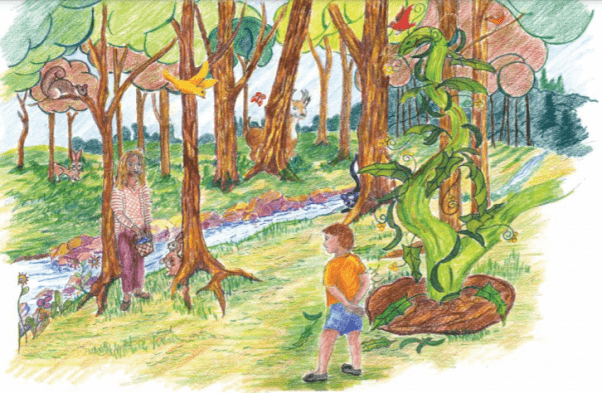
Fun Facts From the Author, Barbara Cole Gates (aka ‘Queen Bean’)
- “I learned that teaching good nutrition was a way to protect children, animals, and nature.”
- “My mom is the illustrator of Jack and the Bean Stew, so it was a family effort, and I inherited much of my love for animals from her.”
- “The story was inspired by the Brothers Grimm fairy tale about compassion for animals ‘The Queen Bee.’”
- “Integrating familiar fairy tale characters engages the kids and lets them be active participants in the story.”
- “I have been a visiting guest author in dozens of classrooms, and we always make Queen Bean’s Stupendous Bean Stew (see below) with the students. As we sit and eat the stew, I read the nutrition information included at the end of the book. Students go home with the recipe and a note to parents so we can extend the lesson further.”
- “When I was a little girl, I loved nature and wanted to protect animals. I would find homes for stray animals and relocate spiders from inside my house to the remarkable outdoors.”
- “Lean & Green Kids has a standards-based nutrition education curriculum, Cool Beans From Around the World,* in which kids learn about wonderful places and wondrous foods.”
*Teachers, we encourage you to use this resource after reading Jack and the Bean Stew. Cool Beans From Around the World includes multiple lessons with activities and recipes for grades K–6.
Dramatic Play Activities
If you’re reading this story with young learners, have them participate by pantomiming scenes from the story and use the empathy stations as extension activities.
Scene: Jack and his family sit down to eat bean stew at the beginning of the story.
- Pantomime: Students can pretend to eat and share bean stew with their friends and family.
- Empathy station: Set up a station in the classroom with kitchen supplies and toy vegetables. Ask students what their favorite vegetable is.
Scene: Jack climbs up the bean stalk and finds himself in a new world.
- Pantomime: Students can stretch their arms up high, as if they were climbing up the bean stalk. Have them show their surprise and joy when they see all the animals in the new world.
- Empathy station: Set up a station with stuffed animals. Have students pretend that each animal is in a suitable habitat. Have them describe their happiness about seeing all the animals in their homes.
Scene: Jack finds the nest of golden eggs.
- Pantomime: Students can pretend to talk to all their new animal friends. They can then show their surprise while you read about Jack’s discovery of the golden eggs.
- Empathy station: Create a nest in the classroom along with fake golden eggs and a stuffed animal Mother Goose. Have students take turns playing the role of Jack, and explain why he makes the right choice in leaving the eggs with the mother.
Scene: Jack helps the fish back into the stream.
- Pantomime: Flexing their empathy muscles, students can pretend to help the fish stuck between the rocks, gently placing him back into the stream. Explain why Jack needed to free the fish.
- Empathy station: Set up a station with a small bucket alongside a blue cloth to simulate a stream. Place a fake fish inside the bucket, and explain to students that the fish needs to be in his natural home in order to be healthy and happy. Have students take turns gently moving the fish from the small bucket to the “stream.”
Allow students to connect with the story in their own way to create lasting empathy for all sentient beings.
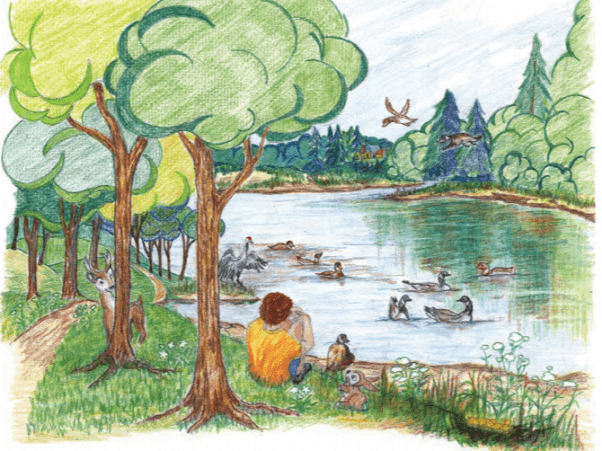
Recipe for Queen Bean’s Stupendous Bean Stew
Encourage students to make this recipe (adapted from the one in the book) at home with a trusted adult. Then ask them what their favorite vegetable in the stew was!
- 3 potatoes, chopped into bite-size pieces
- 1 Tbsp. olive oil
- 1 small onion, finely chopped
- 2 stalks celery, thinly sliced
- 2 cloves garlic, minced
- 1 14.5-oz can crushed tomatoes
- 2 bay leaves
- 1 tsp. thyme
- 1 tsp. oregano
- 4 cups vegetable broth
- 2 carrots, thinly sliced
- 3 cups seasonal vegetables (like zucchini, green beans, spinach, etc.), chopped
- 3 cups cooked beans (kidney, garbanzo, or a mix of your favorites)
- 1 Tbsp. soy sauce
- 1 Tbsp. balsamic vinegar
- 1 cup corn
- Salt and pepper, to taste
In a saucepan, boil or steam 1 of the chopped potatoes until soft. Drain, reserving just enough water to mash the potato. Mash and set aside.
In a large Dutch oven or stockpot, warm the oil over medium heat. Add the onions, celery, and garlic and sauté for about 2 minutes.
Stir in the mashed potatoes and the remaining ingredients, except for the corn, salt, and pepper, and simmer, stirring occasionally, until the vegetables are tender, about 30 minutes.
Add the corn and season with the salt and pepper.
Makes 9 to 10 servings
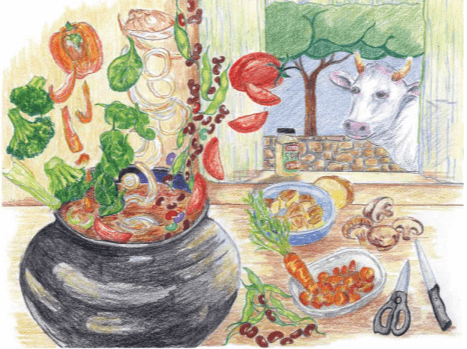
Additional Vegan Nutrition Resources
- Plant Power! An Introduction to Vegan Nutrition for Grades 3–5
- TeachKind Presents ‘Eat Green!’—a Song to Help Kids Learn About Fruits and Vegetables
